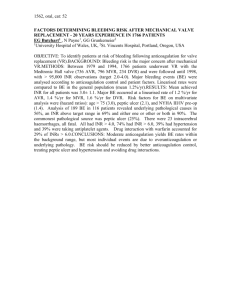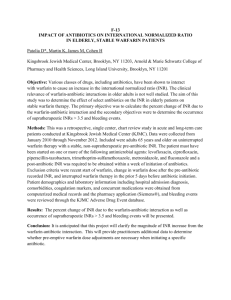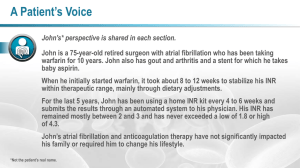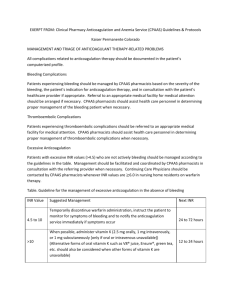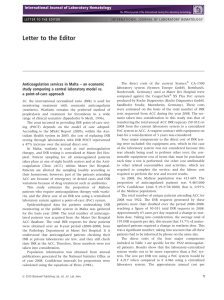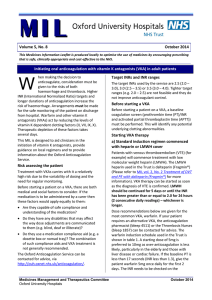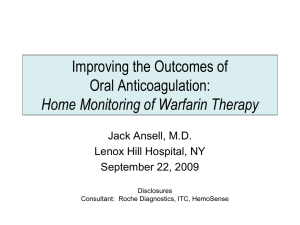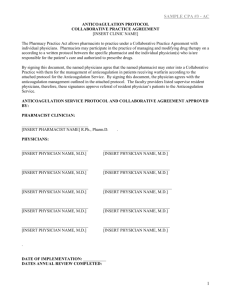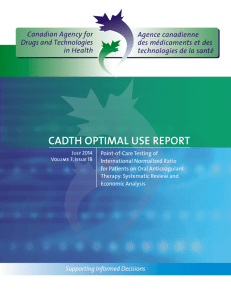Policies and Procedures Example 2
advertisement
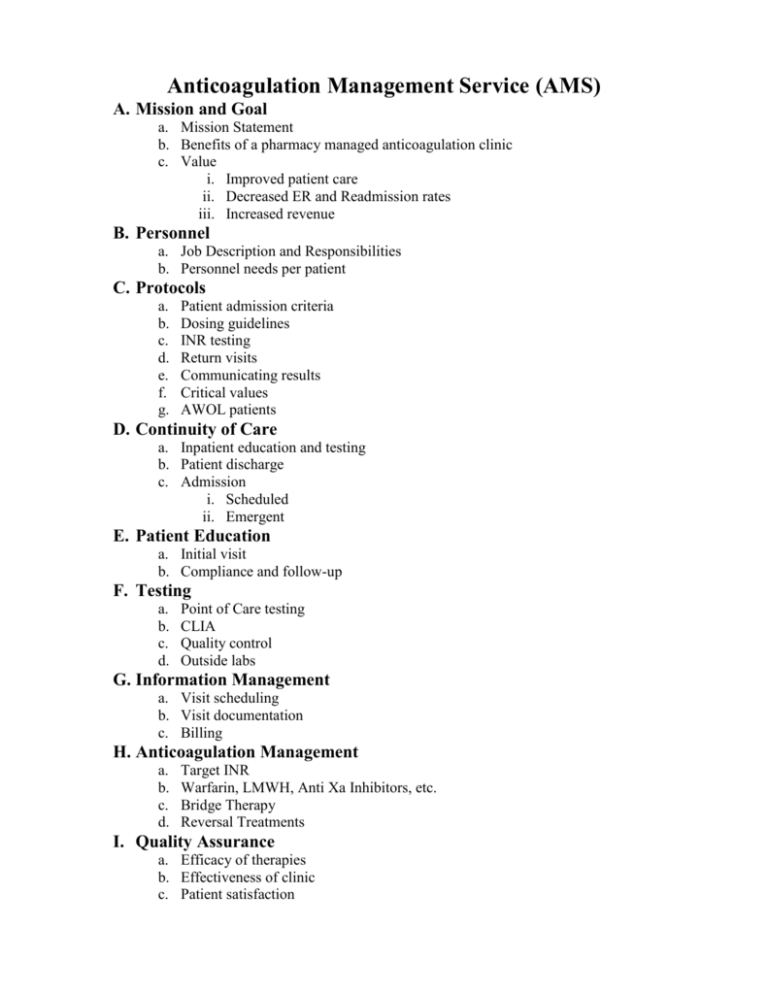
Anticoagulation Management Service (AMS) A. Mission and Goal a. Mission Statement b. Benefits of a pharmacy managed anticoagulation clinic c. Value i. Improved patient care ii. Decreased ER and Readmission rates iii. Increased revenue B. Personnel a. Job Description and Responsibilities b. Personnel needs per patient C. Protocols a. b. c. d. e. f. g. Patient admission criteria Dosing guidelines INR testing Return visits Communicating results Critical values AWOL patients D. Continuity of Care a. Inpatient education and testing b. Patient discharge c. Admission i. Scheduled ii. Emergent E. Patient Education a. Initial visit b. Compliance and follow-up F. Testing a. b. c. d. Point of Care testing CLIA Quality control Outside labs G. Information Management a. Visit scheduling b. Visit documentation c. Billing H. Anticoagulation Management a. b. c. d. Target INR Warfarin, LMWH, Anti Xa Inhibitors, etc. Bridge Therapy Reversal Treatments I. Quality Assurance a. Efficacy of therapies b. Effectiveness of clinic c. Patient satisfaction Mission and Goals A. Mission Statement: Provide the optimal care for patients on difficult to manage anticoagulants such as warfarin utilizing patient education and Point of Care testing as the hallmarks of the program. B. Studies have shown consistently better outcomes through pharmacy managed anticoagulation clinics than traditional programs. C. These studies have demonstrated longer durations in the therapeutic range and decreased bleeding complications. Also, readmission and emergency room visits were reduced. Patient visits can be billed for at the low intensity visit rate as well as the INR test through Medicare and other insurance providers. Personnel: A. A clinical pharmacist with additional training in anticoagulation management, following medical staff approved guidelines, will primarily manage patient care. Responsibilities will include; determine visit schedule, INR testing, dosage adjustment and patient / caregiver education. The primary care physician will be updated on every visit and every dosage change. The pharmacist will also consult the primary care physician when needed. B. Each patient will average 2 visits per month at 15 minutes per visit. For 250 patients = 500 visits/month = 7500 minutes or 125 hours = 20 X 6 hour days per month or one FTE. Education for the initial appointment will increase initial visit time to 30 minutes. Complimentary staff will decrease 15 minute per visit time. i.e. time spent for scheduling, tracking, billing, paperwork. C. Medicare pays $50 per lowest intensive visit (99211 code) (“incident to” rule) plus $15 per INR test. 500 visits per month = $32,500 per month. One FTE expense = $10,800/month. Protocols: see attached. Continuity of Care: A. Patient education will optimally be started in the hospital. Patients being discharged to the AMS will be scheduled for an appointment before discharge. There will be communication between the primacy care physician and the AMS on all admissions and discharges including ER visits. Patient Education: A. All patients will have the option of viewing the warfarin video. All patients will be educated on warfarin, its use and goals, side effects, precautions, testing and schedule. The primary objective is to ensure that every patient understands the correct dosing schedule prior to leaving after each visit. Each patient will be given a dosing calendar to help keep track of doses and schedule. B. Each patient will be instructed on the importance of compliance with drug and INR testing. Testing: A. A Point of Care (POC) device will be used primarily for INR determinations. This will allow immediate feedback to patient to ensure correct understanding and instant gratification. B. The hospital’s CLIA license for waved testing can be used if appropriate quality assurance protocols are followed. C. Prior to use and periodically, the POC device will be compared to standardized tests and/or actual patients to ensure accurate readings. D. Utilizing of outside labs will be minimized if possible due to un-reimbursable follow-up. Information Management: A. A schedule will be maintained on future patient visits. B. Each visit will be documented either in the chart or computer including a brief report on any side effects, compliance, INR, any medication additions, deletions or changes plus additional relevant information. The warfarin dose will be trended along with the corresponding INR. The next scheduled visit will be documented. C. Each visit and test will be coded and billed according to Medicare guidelines. Anticoagulation Management: see protocols Quality Assurance: A. Quality assurance parameters may include treatment and clinic effectiveness, complication rate, and patient satisfaction surveys. Financial Assessment: 500 visits/month Revenue: Patient charge per visit Estimated annual gross revenue Bad Debt (10%) Estimated annual net clinic revenue Revenue increases as visits increase $51.47 (lowest intensity visit) $398,820 ($39,000) $359,820 Expenses: Annual Wages and Benefits Supply Costs ($150,000) ($39,344) Net Profit $170476 Supply Costs: Hemochron Elite POC $0 600 cuvettes $1944 FAX machine $300* Computer $2000 Patient education $2000 CLIA & Quality Assurance $1100** Room & Equipment $30,00* Misc. $2000 TOTAL $39,344 * May be able to use current space and supplies. **If use current CLIA will be less.
